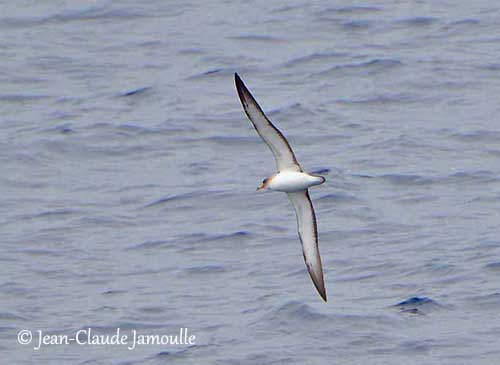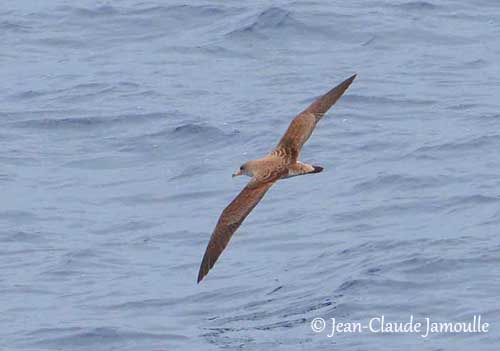
Fr: Puffin de Scopoli (Puffin cendré)
Ang: Scopoli’s Shearwater (Cory's Shearwater (Scopoli's)
All: Sepiasturmtaucher
Esp: Pardela cenicienta mediterránea
Ita: Berta maggiore
Nd: Scopoli's Pijlstormvogel
Sd: scopolilira
Photographer:
Jean-Claude Jamoulle
A la rencontre des Oiseaux
Text by Nicole Bouglouan
Sources:
HANDBOOK OF THE BIRDS OF THE WORLD vol 1 by Josep del Hoyo-Andrew Elliot-Jordi Sargatal - Lynx Edicions - ISBN: 8487334105
ENCYCLOPEDIE DES OISEAUX DE FRANCE ET D’EUROPE – de Peter Hayman et Rob Hume - Flammarion – ISBN : 2082009920
THE HANDBOOK OF BIRD IDENTIFICATION FOR EUROPE AND THE WESTERN PALEARCTIC by Mark Beaman, Steve Madge - C. Helm - ISBN: 0713639601
BirdLife International (BirdLife International)
Wikipedia, the free encyclopaedia
Ornithomedia - Le Web de l’Ornithologie
Agreement on the Conservation of Albatrosses and Petrels
Page family Procellariidae
Summary cards
Scopoli’s Shearwater
Calonectris diomedea
Procellariiformes Order – Procellariidae Family
INTRODUCTION :
The Scopoli’s Shearwater (Calonectris diomedea) is today a full species since the nominate race split into three new species. The Cory’s Shearwater ((Calonectris borealis) and the Cape Verde Shearwater (Calonectris edwardsii) are the two other species, formerly subspecies of C. diomedea.
They have fairly similar appearance, but C. borealis is larger with stouter bill. Some subtle differences are visible on the underwing pattern (see description).
Although being a Mediterranean seabird, the Scopoli’s Shearwater usually winters into Atlantic Ocean, moving rapidly south. However, it may reach the east coast of North America where it is uncommon.
The Scopoli’s Shearwater is widespread and locally abundant throughout its large range, but its population is declining due to the usual threats such as predation by introduced mammals, habitat changes, human pressure and mortality due to longline fisheries off Spain.

DESCRIPTION OF THE BIRD:
Biometrics:
Length: 44-49 cm
Wingspan: 117-135 cm
Weight: 544-738 g
The adult has grey-brown upperparts including crown, nape, hindneck, back, mantle and scapulars where the plumage pattern becomes scaly, like on rump and uppertail-coverts. We can see a whitish crescent formed by the rearmost uppertail-coverts.
The upperwing is darker brown. Primary coverts and flight feathers are darker, whereas tertials and lowermost scapulars are dark, forming an indistinct M or W across the upperparts. The uppertail is mostly blackish-brown.
On the white underparts, the underwing shows dark trailing edge while some dark spots and flecks forming a weak leading edge in the carpal area. The white extends as white fingers into the underside of the outer primaries, whereas C. borealis has dark triangular wing tip.
On the grey-brown head, the face is brownish-grey, merging into the white chin and throat. Neck sides and breast sides are greyish. Rest of underparts is white with brownish wash on thighs.
The bill is olive-yellow with duller and darker tip. The eyes are dark brown. Legs and webbed feet are pale pink to greyish-pink with dark grey outer toes and parts of webs.
Male and female have similar plumage and the juvenile resembles adults.
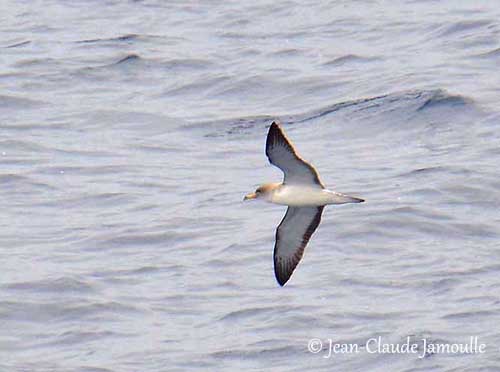
RANGE:
The Scopoli’s Shearwater breeds on the Mediterranean islands including the Balearics, Iles d’Hyères in France, on Elba and small islands off Sardinia and Sicily, Italian islands, in Malta, on coastal Croatian islands (and parts of the mainland) and on Greek islands.
Most populations spend the winter in E Atlantic Ocean and move south in areas off the W coast of Africa and the E coast of Brazil.
This species is uncommon to rare off E North America, from Florida N to New England and W to Texas.
HABITAT:
The Scopoli’s Shearwater is marine and pelagic, rarely seen near or on land except for breeding on barren offshore islands. This species nests on cliffs, in caves, boulder fields and sometimes inland on rocky slopes, often in areas with sparse vegetation. It also nests in burrows dug in soft soil. It can be seen up to 435 metres above the sea-level.
It usually forages over fairly warm waters.
CALLS AND SONGS: SOUNDS BY XENO-CANTO
The Scopoli’s Shearwater is vocal at colonies and usually calls both in flight and from the ground. The female’s voice is lower-pitched. Individual recognition seems to be apparent.
The main call is a harsh, snoring, repeated wail “keeowwrrah-keeowwrrah”, but this species is silent at sea.
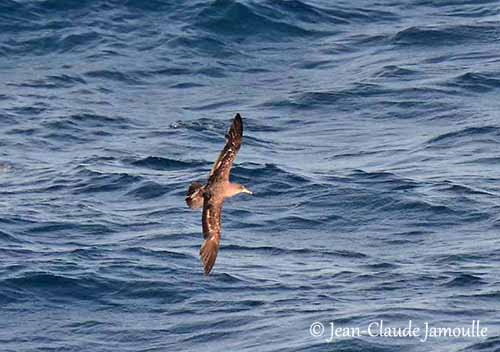
BEHAVIOUR IN THE WILD:
The Scopoli’s Shearwater feeds primarily on fish of numerous species, but it also takes squid and crustaceans, and zooplankton. It takes some offal around the fishing boats during the breeding season.
It is mainly a nocturnal feeder. It feeds usually by pursuit-diving, pursuit-plunging and surface-seizing. It can reach depths of five metres underwater, and may swim by using the wings for propulsion.
They form large flocks at abundant food sources, especially when predators such as dolphins and tuna drive the preys close to the surface.
The Scopoli’s Shearwater returns soon to the colonies, usually in February, because competition for burrows is intense. They are monogamous. The female performs a pre-laying exodus of about ten days. They are nocturnal at their breeding-sites to avoid predation.
The breeding pair often returns to the same nest-site in several following years. Mates seat close to each other and perform mutual preening to strengthen the pair-bonds.
The Scopoli’s Shearwater is migratory and leaves the breeding grounds in October. The Mediterranean populations exit into Atlantic Ocean and move rapidly southwards. Most of birds winter in the Atlantic, including areas off the west coast of Africa and the east coast of Brazil. Other birds may reach South Africa and Indian Ocean.
The Scopoli’s Shearwater is an excellent flier and in strong winds, it flies high in the air. In quiet weather, it flies lazily on arched wings and perform slow wingbeats.
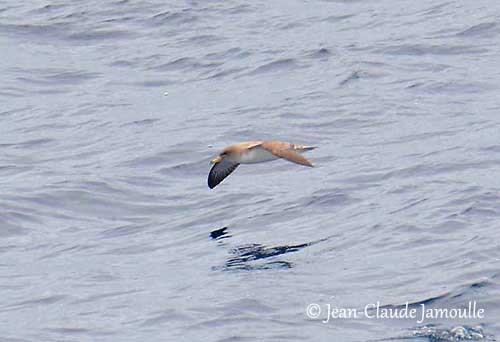
REPRODUCTION OF THIS SPECIES:
The Scopoli’s Shearwater returns to the colony in February and the breeding season starts in April, with the laying in late May/early June, following ten days of pre-laying exodus by female.
This species nests in burrows of two metres long, or in rock crevices and natural hollows, also in deep caves, on cliffs and boulder fields.
The female lays a single white egg and both adults incubate during 50-56 days, with stints of six days (2-8). They are strictly nocturnal at colonies.
At hatching, the chick is covered with brown down and has greyish bill. It is brooded during the first week and then, it is fed at night by its parents. It fledges between 84 and 98 days after hatching. It will be sexually mature at 7-8 years old.
PROTECTION / MENACES / STATUS:
The Scopoli’s Shearwater is threatened by predation on the breeding grounds where black rats, Peregrine Falcons, ferrets, snakes, Eurasian Eagle-Owls and European rabbits cause disturbances or kill both chicks and adults.
However, the species has wide range where it is widespread and locally abundant, but the population is suspected to be declining.
Fisheries bycatch is another threat in the Mediterranean, and numerous birds are killed every year (4-6% of the Spanish breeding population).
The global population has been estimated at 142,478/222,886 pairs in 2012-2013, equivalent to 285,000/446,000 mature individuals.
But in spite of several threats, the Scopoli’s Shearwater is currently evaluated as Least Concern.
